U.S. Army Special Forces Guide to Unconventional Warfare (9 page)
Read U.S. Army Special Forces Guide to Unconventional Warfare Online
Authors: Department of the Army

a. Description.
- This incendiary is composed of potassium chlorate, sulfur, sugar, iron filings and wax. When properly made, it looks like an ordinary building brick and can be easily transported without detection. The incendiary brick will ignite wooden walls, floors, and many other combustible objects.
- This incendiary can be directly ignited by all igniters listed in chapter 3, coupled with a specific delay mechanism found in chapter 5. To ignite this incendiary with White Phosphorus Solution (0209), the solution must first be poured on absorbent paper and the paper placed on top of the brick.
b. Material and Equipment.
| Parts by volume | |
|---|---|
| Potassium chlorate (powdered) | 40 |
| Sulfur (powdered) | 15 |
| Granulated sugar | 20 |
| Iron filings | 10 |
| Wax (beeswax or ordinary candle wax) | 15 |
| Spoon or stick | |
| Brick mold | |
| Red paint | |
| Measuring cup or can | |
| Double boiler | |
| Heat source (hot plate or stove) |
c. Preparation.
- Fill the bottom half of the double boiler with water and bring to a boil.
- Place the upper half of the boiler on the lower portion and add the wax, sulfur, granulated sugar, and iron filings in the proper amounts.
- Stir well to blend all the materials evenly.
- Remove the upper half of the double boiler from the lower portion and either shut off the heat source or move the upper section several feet from the fire.
Caution:
Extreme care should be exercised at this point because accidental ignition of the mixture is possible. Some means of extinguishing a fire should be at hand, a fire extinguisher or sand. It is important to keep face, hands, and clothing at a reasonably safe distance during the remainder of the preparation. A face shield and fireproof gloves are recommended. - CAREFULLY add the required amount of potassium chlorate and again stir well to obtain a homogeneous mixture.
- Pour the mixture into a brick mold and set aside until it cools and hardens.
- When hard, remove the incendiary from the mold, and paint it red to simulate a normal building brick.
d. Application.
- When painted, the incendiary brick can be carried with normal construction materials and placed in or on combustible materials.
- A short time delay in ignition can be obtained by combining Fuse Cord (0101) or Improvised String Fuse (0102) and one of the igniter mixtures found in chapter 3. (For example, several spoonfuls of Sugar-Chlorate mixture (0201) are placed on the incendiary brick. Fuse cord is buried in the center of the igniter mixture and the fuse is taped to the brick. Delay times are determined by the length of the fuse. Suitable delay mechanisms are given in chapter 5 for delay times longer than those practical with fuse cord.)
DELAY MECHANISMS
a. Description.
- This item consists of a bundle of matches wrapped around a lighted cigarette. It is placed directly on easily ignited material. Ignition occurs when the lighted portion of the burning cigarette reaches the match heads. This delay mechanism can be used to initiate all igniters listed in chapter 3 except Magnesium PowderâBarium Peroxide (0210) and Powdered AluminumâSulfur Pellets (0207). A cigarette delay directly ignites the following incendiaries: Napalm (0301), Gelled Gasoline (exotic thickeners) (0302), and Gelled Gasoline (improvised thickeners) (0303).
- The following
dry
tinder type materials may also be directly ignited by the cigarette delay mechanism: Straw, paper, hay, woodshavings and rags. - Usually this delay will ignite in 15 to 20 minutes, depending on length of cigarette, make of cigarette, and force of air currents. A duplicate delay mechanism should be tested to determine delay time for various ambient conditions.
- The cigarette must be placed so that the flame will travel horizontally or upward. A burning cigarette that is clamped or held will not burn past the point of confinement. Therefore, the cigarette should not contact any object other than matches.
b. Material and Equipment.
Cigarette.
Matches (wooden).
Match box.
String or tape.
c. Preparation.
- Picket-fence delay
.
- (
a
) Push one wooden match head into a cigarette a predetermined distance to obtain the approximate delay time. - (
b
) Tie or tape matches around the cigarette with the match heads at the same location as the first match in the cigarette.
- (
- Match box delay.
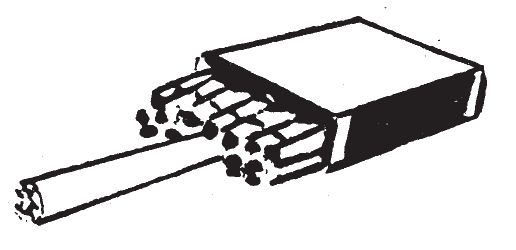
Tear out one end of the inner tray of a box of matches (the end next to the match heads). Push one match into the cigarette. Insert this cigarette into the bunch of matches and parallel to the matches at the center of the pack. Slide the tray out of the inner box, leaving the match heads and the cigarette exposed. The head of the match in the cigarette should be even with the exposed match heads.
d
.
Application.
- Picket-fence delay
.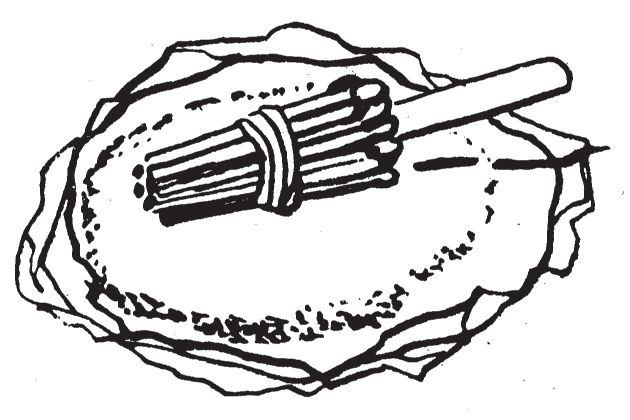
- (a)
Light the cigarette and place the delay mechanism on a pile of igniter mixture, paper, straw, or other dry tinder type material. Be sure that the portion of the cigarette between the lit end and the match heads is not touching anything. - (b)
Pile tinder material all around the cigarette to enhance ignition when the match heads ignite.
- (a)
- Match box delay.
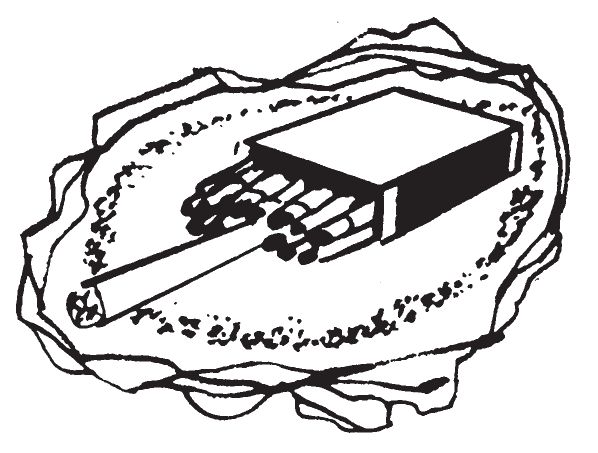
- (a)
Place the delay so that the cigarette is horizontal and on top of the material to be ignited. Light the cigarette. - (b)
Be sure ignitable material such as paper, straw, flammable solvents, or napalm is placed close to the match heads. When using flammable solvents, light the cigarette away from the area of solvent fumes. - (c)
To assure ignition of the target, sprinkle some igniter material on the combustible material. The match box delay is then placed on top of the igniter material.
- (a)
a. Description.
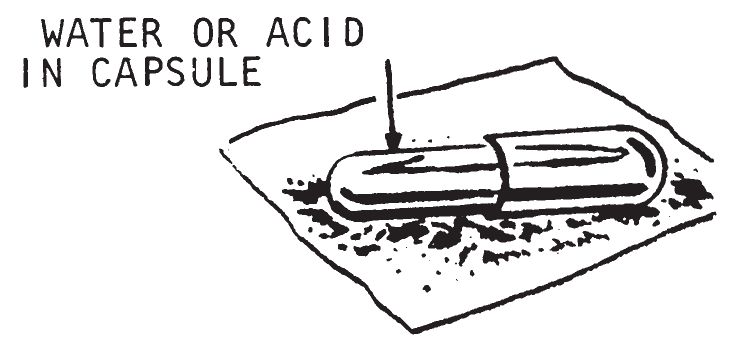
Gelatin capsule delays work by the action of either water or concentrated sulfuric acid on the gelatin. When the liquid dissolves the gelatin, it contacts and reacts with an igniter mix. These delays can be used with various igniters, are easily prepared and easily carried. The disadvantage is that the delay times vary with temperature and they will not work at or below 32° F. Gelatin capsule delays will work with the following igniters:
- Water actuated igniters such as SugarâSodium Peroxide (0203), Silver NitrateâMagnesium Powder (0208), and Aluminum PowderâSodium Peroxide (0204).
- Concentrated sulfuric acid actuated igniters such as Sugar-Chlorate (0201), Fire Fudge (0202), SugarâSodium Peroxide (0203) Aluminum PowderâSodium Peroxide (0204), Match Head (0205), and Silver Nitrateâmagnesium Powder (0208).
b. Material and Equipment
.
Concentrated sulfuric acid or water.
Gelatin capsules (1 fluid ounce capacity).
Igniter mixture.
Glass jar or bottle with glass or plastic stopper for carrying acid.
c. Preparation.
- Fill the gelatin capsule with either water or sulfuric acid, depending on which igniter is being used. Use a medicine dropper to fill the capsule. Wipe the outside of the capsule carefully and place it on a quantity of igniter mixture.
- Gelatin will slowly dissolve in either water or concentrated sulfuric acid, usually faster in water than in acid. Sulfuric acid should be handled carefully and only in glass or unchipped enamel containers.
d. Application.
- Fill a gelatin capsule with one of the igniter mixes listed under
Description
above. Once the liquid is added to the capsule, the next operations should be done quickly. Pile the igniter mixture on and around the capsule. Then place incendiary material in contact with the igniter mixture. (In damp weather this method should not be used with water activated igniters because premature ignition may be caused by humidity in the air.) - Use the following method in damp weather. Fill a gelatin capsule with one of the igniter mixes listed above. Be sure that both halves of the capsule fit tightly and that no igniter mix is clinging to the outside of the capsule. Place the capsule in a shallow glass or porcelain dish filled with water or concentrated sulfuric acid, depending on which type of igniter mix is used. Make sure the capsule is touching one edge of the bowl and quickly pile incendiary material close to the capsule so that when the capsule ignites, the incendiary will also ignite.
- The gelatin capsule delays work slowly in cold weather and will not work at or below 32° F. Capsule thickness also affects delay time. In water at 77° F.. a delay time of approximately 20 minutes can be expected, while the same type of capsule in concentrated sulfuric acid at 77° F. will give a delay time of approximately one hour. At a temperature of 50° F., the same type of capsule will give a 6 to 8 hour delay time in water and about 24 hours delay time in concentrated sulfuric acid. Delay times become less accurate at lower temperatures.
- The above listed delay times are given for one type of gelatin capsule only. Various types of capsules will give various delay times. Therefore, always check delay times for the capsule to be used.
- The sulfuric acid must be concentrated. If only battery-grade sulfuric acid is available, it must be concentrated before use to a specific gravity of 1.835 by heating it in an enameled, heat resistant glass or porcelain pot until dense, white fumes appear. See paragraph 0103 for details.
a. Description.
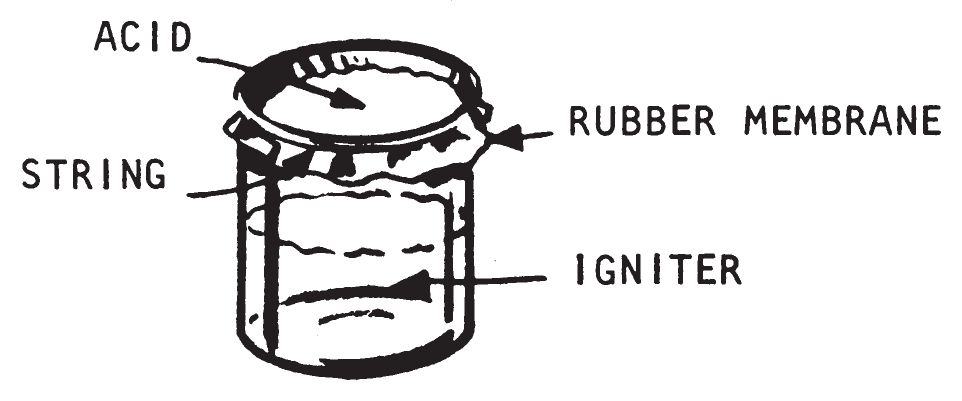
- This delay operates by the action of concentrated sulfuric acid on a thin rubber diaphragm. As the acid eats through the diaphragm, it drips onto the igniter mix and combustion results. This delay can be used to initiate the following igniters listed in chapter 3: Sugar-Chlorate (0201), Fire Fudge (0202), SugarâSodium Peroxide (0203), Aluminum PowderâSodium Peroxide (0204), Match Head (0205), Silver NitrateâMagnesium Powder (0208), and Fire Bottle (0306).
- The delay does not burn or glow, a very desirable feature where premature detection may occur. The main disadvantages of this type of delay areâ
- (a)
Delay time fluctuates with temperature changes. - (b)
Delay is not reliable below 40° F. - (c)
Sulfuric acid involves hazards to the operator.
- (a)
b. Material
and
Equipment.
Concentrated sulfuric acid.
Thin rubber (such as balloons or condoms).
String, tape, or rubber bands.
Glass jar with glass stopper for carrying acid.
Wide-mouthed jar or can (approximately 1 pint capacity).
c.
Preparation.
- Fill the wide mouth container three-quarter full with any one of the following igniter materials:
Sugar-Chlorate (0201).
Fire Fudge (0202).
SugarâSodium Peroxide (0203).
Aluminum PowderâSodium Peroxide (0204).
Match Head (0205).
Silver NitrateâMagnesium Powder (0208).
- Place the rubber diaphragm over the open end of the container and leave it loose enough to sag slightly into the jar. Either tie in place or secure with a rubber band.
- Pour about 1 fluid ounce of concentrated sulfuric acid into a small glass jar with a glass stopper and seal tightly.
d. Application
.
- Place the jar with the rubber membrane at the desired target. Pile the material to be ignited around this jar so that when the flames issue from the jar, they will ignite the incendiary materials.
Do not put any of this igniter material on the rubber membrane.
Pour the 1 fluid ounce of concentrated sulfuric acid onto the rubber membrane. When the acid penetrates the rubber and drips onto the igniter mix, a chemical reaction occurs and combustion results. - The time delay of this device depends on the kind and thickness of rubber used, and on the ambient temperature. Test a similar device before actual use on the target.
- Using a thin rubber membrane such as a condom at a temperature of 77° F., a delay time of 15 to 20 minutes is normal. This same delay when tested at 40° F. may take as long as eight hours to penetrate the rubber membrane. Do not use this delay at temperatures below 40° F.
- Another simple method of using this type of delay is to first fill a small jar half full of concentrated sulfuric acid. Tie or tape a rubber membrane over the open end of the jar. BE SURE NO ACID CAN LEAK OUT. Place the bottle on its side, on top of a small pile of igniter material which will ignite on contact with the acid. When the acid penetrates the membrane, combustion will occur as before. If thicker rubber is used, stretch the rubber tightly over the mouth of the jar. This will decrease the delay time because the acid will attack the stretched rubber more effectively.

- A rubber glove may also be used as a membrane for this delay. Pour some concentrated sulfuric acid into the glove and suspend the glove over a pile of igniter material. When the acid eats through the glove, it will drip onto the igniter and start a fire. A rubber glove will give a longer delay time than a condom because the material is thicker.
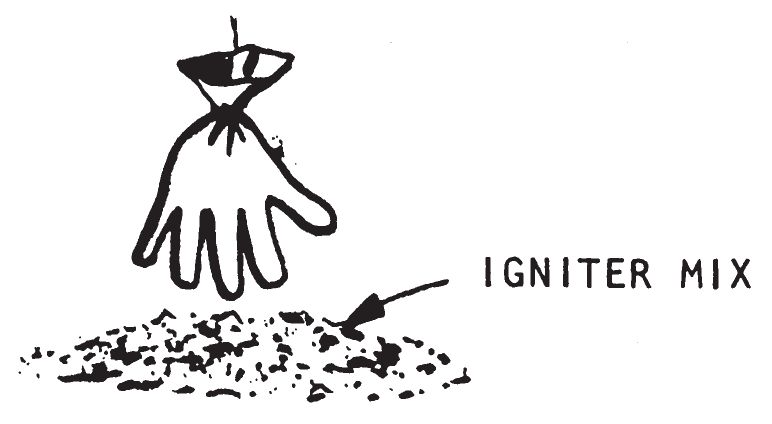
- The rubber membranes for use in this delay must be without pin holes or other imperfections. The sulfuric acid must be
concentrated.
If only battery-grade sulfuric acid is available, it must be concentrated before use to a specific gravity of 1.835 by heating it in an enameled, heat-resistant glass or porcelain pot until dense, white fumes appear. See paragraph 0103 for details.
